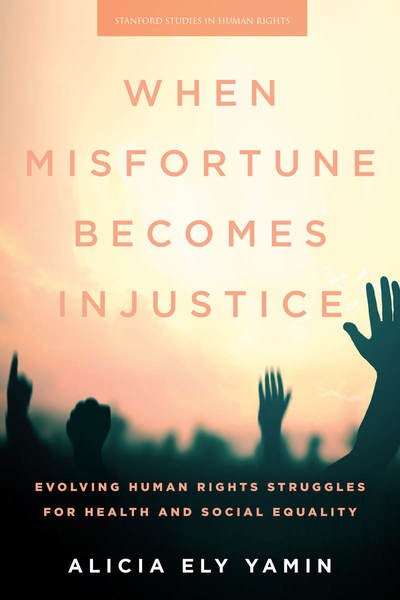
《When Misfortune Becomes Injustice》"Unjustly Blaming Misfortune: A Review"

大话西游 2023-10-05 02:25:54
Yamins central argument in the book is that health equity, and social justice more broadly, will only be achieved by tackling injustice in all its forms. This requires adopting a human rights approach that focuses on economic, social, and cultural (ESC) rights. Yamin notes that ESC rights have long been neglected by international human rights scholars and activists because they are traditionally seen as "programmatic" and not as constituting "real legal rights" in the way that civil and political rights (CP) are. Yamin argues forcefully throughout the book that "we cannot isolate an individual or populations health from the sociopolitical and economic contexts, including the design of health systems, that produce patterns of (ill) health" (p. 63).
Yamin draws on her personal experiences working as an international human rights lawyer at Harvards Center of Economic and Social Rights to provide a rich description and critical analysis of human rights struggles that have used ESC rights to push for health equity. Most of the examples and case studies presented in the book focus on sexual and reproductive health violations, such as forced abortions, forced sterilizations, and obstetric violence in Latin America. There is also a brief nod to some of her experiences in Africa.
It is impossible not to marvel at Yamins skill at weaving together a book that is theoretically rich while also through she presents a very personal plea that we recognize and respect the dignity and humanity of the worlds most vulnerable and marginalized people: women and girls. Yamin rebukes states and international institutions whose political and economic policies create the "opportunity structures" (p. 8) that enable some of the worlds most egregious human rights violations. She shows how neoliberal economic reforms promoted by the World Bank and the International Monetary Fund, under the guise of "development" and "progress," have contributed to human rights abuses in Latin America and Africa by, among other things, privatizing healthcare and making it difficult for women—and poor people, in general—to afford sexual and reproductive health services. Forced sterilizations in Peru and forced abortions in Argentina can, and should, be traced directly back to the political and economic decisions and (in)actions of states and international institutions. Injustice and human suffering result directly from these policies and are not due to mere misfortune, Yamin insists.
By broadening the framework to include economic and social contexts, this book makes a substantial contribution to the scholarship on health and human rights. The book also provides the reader with an in-depth "behind-the-scenes" look at the actual work that goes into applying international human rights law to advocate for health equity nationally and internationally. We see local human rights organizations—sometimes on their own and sometimes in partnership with international organizations—successfully use international human rights legal instruments to seek restitution for human rights violations that are all too often ignored or easily dismissed as being due to poverty. But, as Yamin argues, even "poverty is a political choice" (p. 179) and not an unfortunate social condition beyond states control. The book clearly shows that a key strength of focusing on ESC rights is that it places states under public scrutiny and makes them accountable for the inhumane conditions under which many of their citizens live. International human rights law helps to "catalyze dialogue with political organs of the government" (p. 150). This is important even in those instances where it is impossible to enforce rulings that draw on international rights law.
Although there are many examples of successful human rights advocacy in the book, the subject matter explored in the book is grim and sobering. Womens dignity and humanity are still perpetually under threat and many state policies appear designed to penalize women for their "natural processes of reproduction" (p. 149). The book also traces the systematic erosion of many of the gains made by womens rights groups since the 1970s. For instance, many structural-level changes were made during the United Nations Decade for Women (1975-1985) and the 1995 Beijing Platform for Action clearly outlined 12 priorities for advancing womens security and human rights nationally and internationally. Yamin attributes much of this erosion to the "professionalization" and outsourcing of human rights advocacy to technical "experts," particularly in recent global efforts around the UNs Millennium Development Goals (adopted in 2005) and the UNs Sustainable Development Goals (adopted in 2015). She notes a worrying obsession with measurement and the development of indicators which, unfortunately, "do not challenge pathologies of power" (p. 179).
Source: Masvawure, T.B. (2021). Book Review: When Misfortune Becomes Injustice: Evolving Human Rights Struggles for Health and Social Equality. Humanity & Society, 45(1), 131-133. https://doi.org/10.1177/0160597620982727
相关推荐
萤火谷的梦想家
艾莉森•麦吉出生于1960年,是美国《纽约时报》畅销书作家,同时也是大都会州立大学创意写作课的教授。她的作品被翻译成20多种语言并出版,也曾被提名普利策奖,并获得苏斯博士奖金奖、克里斯托弗图书奖、美国 [美]艾莉森•麦吉/[美]克里斯托弗•丹尼斯/绘 2023-03-27 16:50:25鬼马女神捕1·绝密卧底(上)
腹黑凤凰vs毒舌鸡妖——蓝翎:“小姬,跟我去人界吧!”姬十四:“干吗?让人宰了我做小鸡炖蘑菇吗?”蓝翎:“不啊,让妖怪宰了你做小鸡炖蘑菇更气派。”凤凰蓝翎和鸡妖姬十四生活在无忧无虑的灵界。他们的故乡叫 郝天晓 2023-04-17 00:22:47© 2023-2025 百科书库. All Rights Reserved.












发表评价